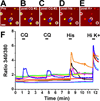Cross-sensitization of histamine-independent itch in mouse primary sensory neurons
- PMID: 23000623
- PMCID: PMC3489980
- DOI: 10.1016/j.neuroscience.2012.09.019
Cross-sensitization of histamine-independent itch in mouse primary sensory neurons
Abstract
Overexpression of pruritogens and their precursors may contribute to the sensitization of histamine-dependent and -independent itch-signaling pathways in chronic itch. We presently investigated self- and cross-sensitization of scratching behavior elicited by various pruritogens, and their effects on primary sensory neurons. The MrgprC11 agonist BAM8-22 exhibited self- and reciprocal cross-sensitization of scratching evoked by the protease-activated receptor-2 (PAR-2) agonist SLIGRL. The MrgprA3 agonist chloroquine unidirectionally cross-sensitized BAM8-22-evoked scratching. Histamine unidirectionally cross-sensitized scratching evoked by chloroquine and BAM8-22. SLIGRL unidirectionally cross-sensitized scratching evoked by chloroquine. Dorsal root ganglion (DRG) cells responded to various combinations of pruritogens and algogens. Neither chloroquine, BAM8-22 nor histamine had any effect on responses of DRG cell responses to subsequently applied pruritogens, implying that their behavioral self- and cross-sensitization effects are mediated indirectly. SLIGRL unilaterally cross-sensitized responses of DRG cells to chloroquine and BAM8-22, consistent with the behavioral data. These results indicate that unidirectional cross-sensitization of histamine-independent itch-signaling pathways might occur at a peripheral site through PAR-2. PAR-2 expressed in pruriceptive nerve endings is a potential target to reduce sensitization associated with chronic itch.
Copyright © 2012 IBRO. Published by Elsevier Ltd. All rights reserved.
Conflict of interest statement
CONFLICT OF INTEREST
The authors state no conflict of interest.
Figures






References
-
- Amadesi S, Nie J, Vergnolle N, Cottrell GS, Grady EF, Trevisani M, Manni C, Geppetti P, McRoberts JA, Ennes H, Davis JB, Mayer EA, Bunnett NW. Protease-activated receptor 2 sensitizes the capsaicin receptor transient receptor potential vanilloid receptor 1 to induce hyperalgesia. The Journal of neuroscience : the official journal of the Society for Neuroscience. 2004;24:4300–4312. - PMC - PubMed
Publication types
MeSH terms
Substances
Grants and funding
LinkOut - more resources
Full Text Sources
Medical
Molecular Biology Databases
Research Materials

